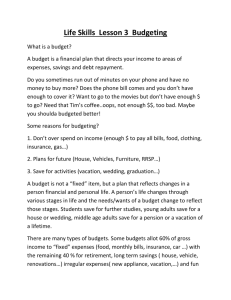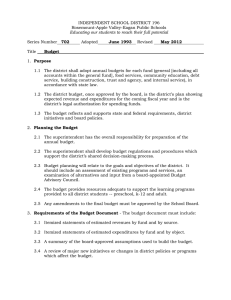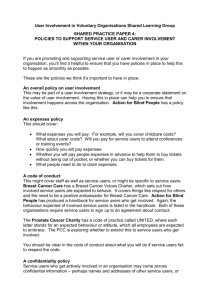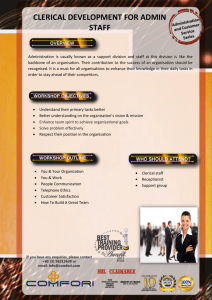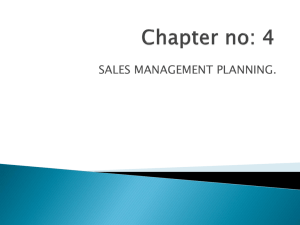Business & Administration Student Handbook Level 3
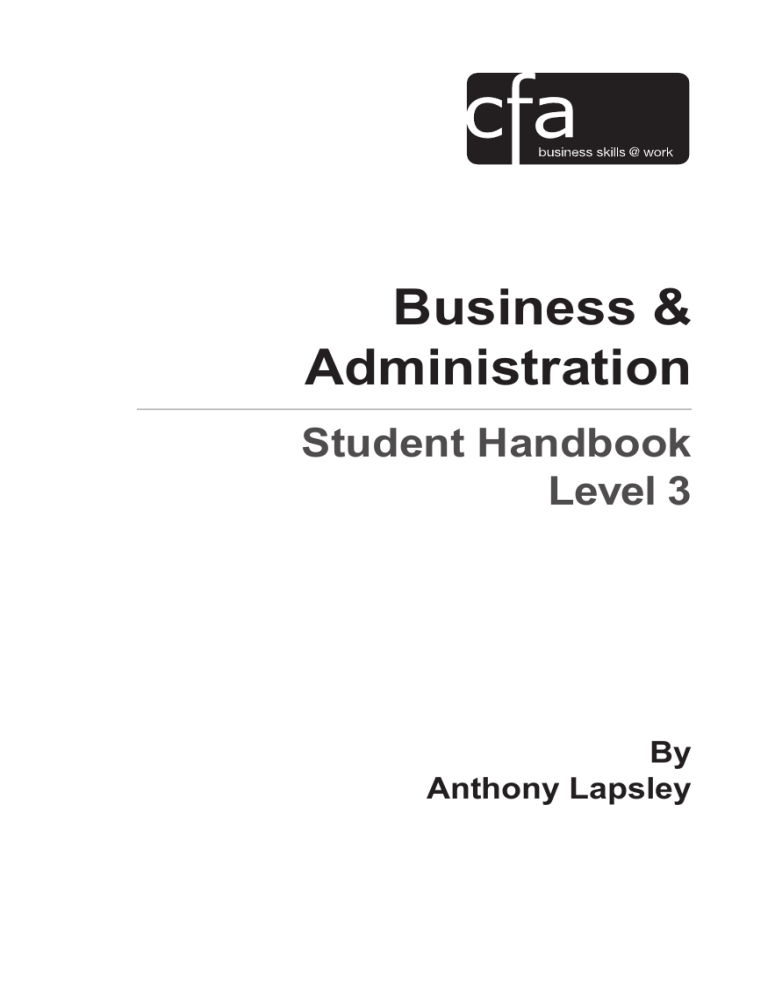
Business &
Administration
Student Handbook
Level 3
By
Anthony Lapsley
C O N T E N T S unIt tItLE
Business resources
1 Agree a budget
2 Order products and services
Business support services
3 Supervise an office facility communications
4 Develop a presentation
5 Communicate in a business environment
6 Deliver a presentation core business and administration
7 Manage own performance in a business environment
8 Evaluate and improve own performance in a business environment
9 Work in a business environment
10 Contribute to decision-making in a business environment
11 Negotiate in a business environment
12 Solve business problems
13 Work with other people in a business environment
14 Supervise a team in a business environment customer service
15 Deliver, monitor and evaluate customer service to internal customers
16 Deliver, monitor and evaluate customer service to external customers
Innovation and change
17 Contribute to innovation in a business environment document production
18 Design and produce documents in a business environment
19 Prepare text from notes using touch typing (60 wpm)
20 Prepare text from shorthand (80 wpm)
21 Prepare text from recorded audio instruction (60 wpm)
Events and meetings
22 Plan and organise an event
23 Coordinate an event
24 Plan and organise meetings
25 Organise business travel or accommodation
26 Evaluate the organisation of business travel or accommodation
Manage information and data
27 Support the design and development of an information system
28 Monitor information systems
29 Analyse and report data
Project management
30 Contribute to running a project
Index
PAgE
1
19
47
77
97
141
169
195
217
257
287
309
333
361
391
415
439
467
497
527
553
579
607
623
649
671
685
713
739
765
1
Unit 1 | Agree a budget
AgrEE A BudgEt
‘Agree a budget’ is an optional unit which may be chosen as one of a combination of units to achieve either a Qualifications and Credit
Framework (QCF), National Vocational Qualification (NVQ) or Scottish
Vocational Qualification (SVQ).
The aims of this unit are to:
• Understand how to develop budgets
• Be able to agree a budget
To achieve the above aims of this unit, learners will be expected to provide evidence through the performance of work-based activities.
Knowledge
Purpose and types of budgets
A budget is a plan that shows the amount of money that an organisation intends to spend within a specified period of time. It expresses the money value in whatever currency an organisation is budgeting the future human and material resources requirements identified in action plans - the budget acts as a road map to carry out an organisation’s objectives, strategies and assumptions.
The budget will identify sources of revenue or income and expenditure, e.g. salaries, benefits, supplies and travel.
Therefore, it is a financial document used to project future income and expenses. In planning a budget, potential use of resources should be aligned with an organisation’s strategic plan. The process of budgeting will cascade down through each department or division of the organisation from the strategic plan. A budget can communicate an organisation’s values and identify its priorities. The budget can then be used to determine if resources are being appropriately and beneficially used to achieve the organisation’s mission and objectives.
Other goals that a budget can achieve for an organisation include:
• Control and evaluation - Having a budget allows a company to have a certain degree of control over costs. A budget gives a company a benchmark by which to evaluate its business units, departments etc., and individual managers. Unfortunately, the latter purpose can cause employees to have negative feelings about the
2 | Level 3 | Student handbook
Unit 1 | Agree a budget budgeting process because their jobs may be dependent on meeting certain budgeting goals. This is especially true in companies when budgeting is a top-down process, rather than participative
• Planning - Arguably the main purpose of a budget. Planning a budget allows a business to take stock of revenue and expenses from the previous period, and judge where the business will be in future periods. It also allows organisations to add and remove products and services from its plan for the future period. Planning a master budget allows senior management to gain a picture of the entire business so they are better able to prioritise their business plans
• Communication and motivation - Budgets allow management to communicate goals so resources can be coordinated and focused in key areas. Budgets also allow an organisation to motivate its employees by involving them in the planning of a budget, where possible. When an employee is involved in creating their department’s budget, that employee will be more likely to strive to achieve the goals of the budget
A budget is also an important step in overall business strategic planning.
• ACTIVITY 1
What is a budget and what is it designed to achieve?
The budgeting process is carried out by all types of business regardless of size, as any organisation will need to estimate whether they can continue to operate within its projected income and expenses. A budget may be prepared using paper and pencil; a computer, using a spreadsheet program like Excel, or with a financial application designed specifically to meet the needs of budgeting drawn up by the organisational objectives. The process for preparing a budget for a specified period of time includes:
• Listing all sources of income, e.g. government grants
• Listing all required, fixed expenses, e.g. salaries, rent, mortgage, utilities, telephone
• Listing other possible and variable expenses, e.g. use of consultants for specific projects
Most organisations will have a master budget or profit plan for the
Level 3 | Student handbook | 3
Unit 1 | Agree a budget upcoming year. It is common that budgets prepared for the next accounting year will be prepared and reported quarterly or monthly.
It is also typical that the annual budget will not be changed once the actual year begins. In rare circumstances the annual budget might be revised, but only when a business environment has radically changed.
The master budget will include a projected income statement and balance sheet. The master budget will identify operating budgets, e.g. a sales budget, production budget, marketing budget, administrative budget, and budgets for each department in an organisation. Every constituent part of an organisation will have an operating budget, which is the blueprint for the core functions it will perform over the life of the budget. Each constituent part of an organisation may be asked to identify resources in its operating budget that will be transferred to the organisation’s capital expenditure budget, which includes the resource plans for building or renovating new facilities, buying major pieces of equipment or improving the an organisation’s infrastructure. There will also be cash budgets.
• ACTIVITY 2
What is a cash budget?
Other types of budgets include: rolling budgets
Also known as a continuous budget, a perpetual budget or a rolling horizon budget always provide for a budget that will look ahead for one full year. A rolling budget could use three-month periods or quarters instead of months. An organisation may have a five-year rolling budget for capital expenditures. In this case a full year will be added to replace the year that has just ended. This means that an organisation will always have a five-year planning horizon.
Static budgets
Are budgets that do not change as volume changes, e.g. if it is estimated that sales commission will be £200,000 for the year, it will remain in the budget even if sales commissions have reached £4 million. However, the sales department may have a flexible budget. In the flexible budget, the sales commission expense budget might be expressed as 5% of sales. In this instance, the department’s budget for sales commission expenses will be £200,000 when actual sales are £4 million, but it will decrease to £150,000 when actual sales are £3 million,
4 | Level 3 | Student handbook
Unit 1 | Agree a budget and the budget will increase to £300,000 when actual sales are £6 million, and so on.
Flexible budgets
Are budgets that adjust or accommodate changes in the volume of activity. The flexible budget is more sophisticated and useful than a static budget. For example, suppose an HR department estimates the cost of its service is £100 per day. It also knows that the office supervision, depreciation and other fixed costs are approximately £40,000 per month
- 20 working days. The office has 50 employees working on a full-time contract of a five-day week. Based on this information, the flexible budget for each month would be £40,000 + £100 x 50 x 20 (£100,000) =
£140,000. If, as a result of redundancies to the department, the number of employees working in the HR department decreased to 40 and then
30 employees over two consecutive months, then the flexible budgets for those two months would be £120,000 and £100,000, respectively.
The flexible budget provides a better opportunity for planning and controlling than a static budget.
A budget should be flexible enough to enable the organisation and its constituents to take advantage of unexpected opportunities and cope with fluctuations in planned resources which have not been anticipated.
Good managers recognise that a budget is only a guide and that it cannot be so rigid that it prevents timely action when needed. Budgeting is the process of matching planned uses to available resources.
• ACTIVITY 3
What are the advantages and disadvantages of a flexible budget over other types pf budgets?
During the specified period of time within which an agreed budget will operate, the budget is a tool for monitoring and controlling the generation and use of resources. By comparing actual results with the budget plan, an organisation can make adjustments to the budget. The budget also provides the foundation for future budgets and is a valuable tool for evaluating the accuracy of the planning assumptions it has made.
Level 3 | Student handbook | 5
Unit 1 | Agree a budget
The basis of any budget is estimating the amount of resources an organisation needs to deliver its services and the costs of those resources. For example, a project will need to identify the amount of time it will take to achieve its aims and purpose. Initially, consideration will be given to the amount of time to complete the project. Within this time, how many people will need to be involved in each stage of the milestones of the project? Within each milestone, identify the resources required to complete a milestone.
From this, the project manager responsible for drawing up the budget can determine the number of people involved over the life of the project, which can be accounted for in total salaries. They can then make an estimate of the resources each team within the project will need to complete their tasks to arrive at an estimated total budget for the project.
Estimating budgets
Trying to estimate the income and expenditure / costs for a budget is an essential function of managers to make sure they are able to continue to make responsible decisions and maintain control of their department
/ team. Cost estimates will need to be made to assist with pricing decisions. The estimator should have a good working knowledge of the way the organisation’s cost accounting system operates. There are four major costs that need to be considered when agreeing a budget:
• Fixed costs - Are expenses that do not vary because of other transactions but remain constant over specified periods of time, e.g. rent. Fixed costs are generally fixed in the short term
• Variable costs - Are expenses that change in proportion to the activity of a business. A variable cost is the sum of marginal costs of all units produced. It can also be considered as a normal cost.
Variable costs are generally fixed in the long run
• Direct costs - Are expenses that can be identified with a specific cost centre or cost object, e.g. a department, process or product.
Direct costs, e.g. materials, fuel or power, vary with the rate of output but are uniform for each unit of production, and are usually under the control and responsibility of a department manager. A direct cost is also known as a direct expense, on cost, operating cost, prime cost, variable cost or variable expense, which are grouped under variable costs
6 | Level 3 | Student handbook
Unit 1 | Agree a budget
• Indirect costs Are expenses that arise from joint usage and are difficult to identify with a specific cost object or cost centre, e.g. advertising, maintenance. Indirect costs are usually constant for a wide range of output and are grouped under fixed costs
• ACTIVITY 4
What are the different costs that need to be considered when estimating a budget?
Estimating expenditures for a business is not just about making guesses. Though it is not an exact science, past data and previous experience can be used to make an educated estimate, creating a more realistic budget. The estimator will use a good degree of subjective judgement when making decisions about the budget. Judgements made need to be as accurate as possible. Past data that can be used includes, using receipts, credit card bills and purchase order books from previous years to track any increases and calculate the percentage increase, which can then be projected into the future. Another approach is to track spending for a month or two, identifying all expenditure that has been made in the organisation or department. This will provide a sense of the organisation’s expenditure in the future. It may also provide a valuable aid to minimising or eliminating wasteful or unnecessary expenditure.
A budget is only successful if the estimates of income and expenses are feasible. The steps involved in making an educated estimate are as follows:
• Start with what is known - e.g. the rent of a building is constant over a year, so is a known expenditure. If there is an item of expenditure that is constantly happening every month for six months, use this to estimate the next six months expenditure activity for this item
• Anticipate increased / decreased expenses due to external economic factors - e.g. the Bank of England raising interest rates.
Use percentage changes if money values are not known
• Review previous data of expenditures - The more data that can be collected the better the educated estimate will be, because patterns can be cyclical and may repeat themselves
Level 3 | Student handbook | 7
Unit 1 | Agree a budget
• Overestimate, if necessary - It is better to have more money for expenses than to fall short. For example, if public relations’ expenses have been averaging £1,650 per month, then increase this expense to £1,800 per month
• Research similar businesses - Ask other professionals or other businesses what they would estimate for their expenses. Not all businesses are alike, but there are similarities. Small businesses can be extremely volatile, as they are more susceptible to industry downturns. Do not be too specific, but look for average amounts
• Break a project into stages or milestones - Which correspond to the deliverables, which is broken down further into specific tasks, estimating the man hours that will be spent on each task. Add additional management hours or a contingency, depending on the approach to the project. Business development costs should be spread across each of the stages of the project
• ACTIVITY 5
What are the steps that can help to make an educated estimate of a budget?
There are four types of estimators with different styles for estimating income and expenditure which will have an impact on the final budget, which are:
• Optimistic - Where income and expenditure is overestimated
• Pessimistic - Where income and expenditure is underestimated
• Inconsistent - Where income and expenditure is estimated ranging from the optimistic to the pessimistic
• Accurate - Where income and expenditure is consistently estimated at about the correct levels
The best way to make educated estimates on expenditure is to know as much as possible about what needs to be paid out of the business.
Expenses are not always precise. There will be occasions when expenditure is required for an unforeseen circumstance. So, if possible, always allow for a little extra for unexpected circumstances. Expecting the unexpected will help in preparing for those expenses which have not been planned for. Always build some degree of flexibility into a budget.
There are two main areas to analyse when reviewing a budget:
8 | Level 3 | Student handbook
Unit 1 | Agree a budget
Actual income
Each month compare actual income with the budget. To do this:
• Analyse the reasons for any shortfall, e.g. decrease in sales of a product
• Consider the reasons for a particularly high turnover, e.g. if targets were too low
• Compare the timings of income with projections and check that they fit
Actual expenditure
Regularly review actual expenditure against the budget, which will help to predict future costs with greater reliability, which can be done by:
• Looking at how fixed costs differ from the budget
• Checking variable costs were in line with the budget
• Analysing any reasons for changes in the relationship between costs and turnover
• Analysing any differences in the timing of any expenditure, e.g. check suppliers’ payment terms
Analysing these variations will help to set future budgets more accurately and also allow a manager to action variations where needed.
creating a budget
Creating a budget is for keeping an organisation’s financial house in order. To create a budget it is important to provide as much detailed information as possible to guide the decision-making process.
Ultimately, the end result will be able to show where your money is coming from, how much is there and where it is all going. To create a budget:
• Make time for budgeting - Investing quality time to create a comprehensive and realistic budget will make it easier to manage and ultimately be a more effective budget
• Create realistic budgets - Use historical information, business plans and any changes in operations or priorities to budget for overheads and other fixed costs. Make sure budgets contain enough information to easily monitor the key drivers of the business, e.g. sales, costs and working capital
• Involve the right people - Ask staff with financial responsibilities
Level 3 | Student handbook | 9
Unit 1 | Agree a budget within the business to provide estimates of figures for the budget, e.g. production costs. A more realistic budget can be achieved by balancing their estimates against those drawn up by the budget line holder. This involvement will give employees a greater commitment to meeting the priorities of a budget
• Gather every available financial statement - Which includes bank statements, investment accounts, recent utility bills and any information regarding a source of income or expense. The key for this process is to create a monthly average so the more information that can inform this the better
• Record all sources of income
• Create a list of monthly expenses - List all the expected expenses over a specified period of time
• Break down expenses into two categories - Fixed and variable costs
• Total the income and expenses for a specified period of time - If expenses are higher than the income look at variable expenses to find where they can be cut
Once a budget has been agreed, take some time to stand back from it and review all the cost decisions that have been made to make sure that they are realistic. As an organisation lives in a dynamic business environment, budgets should be reviewed regularly to make sure everything is financially on track, particularly if the business is growing and planning to move into new areas. An up-to-date budget enables managers to be flexible, manage cash flow and identify what needs to be achieved in the next budgeting period.
• ACTIVITY 6
What steps should be carried out to create a budget?
negotiating a budget
There is very little difference in the negotiating strategy that needs to be undertaken to agree a budget. There will be a number of players involved in the decision-making process. Each one will be fighting for the supremacy of their budget lines which they will back up with facts to support their argument.
10 | Level 3 | Student handbook
Unit 1 | Agree a budget
Negotiation takes place in three stages:
1. Preparation
The amount of time allocated to preparation will depend upon the complexity and importance of the budget being negotiated. There are five key issues to be identified when preparing to negotiate:
• What is the budget aiming to achieve?
• What are the priorities of the budget?
• How important is each stakeholder’s contribution to the budget in relation to each other? Whose budget line is more important than others budget lines?
• What is each budget line’s opening bid? This is going to be the best that each contributing budget holder can hope to achieve. This applies to all of the budget lines of the budget, which may apply to just a department or across the organisation.
Once a budget line holder has stated what they are willing to accept, they will be negotiating towards less acceptable terms not better
• What is the budget line contributor’s walk-away position? This is the least the budget line contributor is willing to accept
There will be a number of things a budget line holder wants to achieve.
Generally, the negotiation process will not always fulfil all budget line holders’ needs. There will be some compromising that will probably take place. Each budget line holder will need to identify the relative importance of each need and decide which they are prepared to concede to achieve the others. The budget line holder should try to establish what the other side’s position is likely to be on similar issues and to establish some common ground from which the negotiation can start. Negotiations are best carried out in an atmosphere which encourages agreement. If negotiations are taking place face to face:
• Make sure to arrive on time
• Start the negotiation by confirming those areas that are already agreed
• Be seen to be listening to the other party
• Avoid making quick decisions
Level 3 | Student handbook | 11
Unit 1 | Agree a budget
All budget line holders should find out what each budget line is hoping to achieve, which should be aligned to business plans so priorities can be identified and agreed. Normally, there will be some compromises that will need to be agreed between budget line holders. Having a good plan in place identifying the prioritised outcomes of a project or plan will present a more convincing argument than if figures are just being picked out of the air.
2. Discussion
The discussion stage should avoid starting with an argument.
Arguments do not move negotiations forward. All sides should be suggesting solutions to overcome issues. This will help to move the negotiation into the bargaining stage, where one side offers to give up one of their needs in exchange for a concession from the other side, e.g. a budget line holder may decide to reduce their budget line if the other department worked more closely with them providing additional manpower. Each budget line holder should already have decided during the preparation stage the relative importance of their budget line and will argue to achieve it.
There are recognised negotiation strategies used by negotiators during negotiations; however, other negotiators will recognise them for what they are and will have developed countermeasures to combat them.
Examples of well-known negotiation strategies and their counter strategies are:
• Good cop / bad cop - Where two members of a negotiating team adopt the role of one person who is difficult to negotiate with and another person who is looking for an agreement. This strategy is designed to make the opposing party accept the offer put forward by the ‘good cop’ because it is so much better than that being insisted on by the ‘bad cop’. The counter strategy is to adopt a similar strategy
• The builder strategy Where the strategy is to negotiate a budget that includes everything. The opposing party will want to include extra costs as they are incurred. The counter strategy is for the purchasing negotiator to make their specification extremely detailed
12 | Level 3 | Student handbook
Unit 1 | Agree a budget
• The double-glazing salesman ploy - The opposing negotiators put forward what sounds like an attractive offer but impose a strict deadline on acceptance of the offer. The counter strategy is for the opposing negotiator to make it clear from the beginning what their time frame is for making the decision
• The lesser of two evils - The opposing negotiator gives the other negotiator a choice between two offers, one of which is so terrible that the other negotiator purchaser will accept the other which, although bad, is not as bad. The counter strategy is to refuse to accept either offer and defer to a higher authority in the organisation for agreement
• The ‘shirt off my back’ approach - The opposing negotiator convinces the purchasing negotiator that even their best offer is so unreasonable that they would be left in an impossible position if they accepted it. The counter strategy is for the purchasing negotiator to make their best offer and stick to it
The end of the discussion stage will aim to reach an agreement where all sides have a deal which is better than their walk-away position and as near as possible to their opening bid. It is possible that all parties may not be able to make an agreement, and so the process begins again. Make sure the terms of the agreement are minuted and signed by both parties so there can be no confusion over what was agreed.
3. Implementation - No negotiation is complete until an agreement has been fulfilled by all budget line holders, i.e. delivery of the final budget negotiated to achieve the priorities that each budget line holder has identified and agreed. Any failure to meet the agreed terms will require the reopening of negotiations.
Any failures during the negotiation process mainly occur in the preparation and implementation stages.
The following budget sets out what a budget may look like for a small firm in one financial year from 1 April to 31 March.
Level 3 | Student handbook | 13
Unit 1 | Agree a budget
Category
Net Sales cost of goods
Merchandise Inventory, 1 April
Purchases
Freight Charges
Total Merchandise Handled
Less Inventory, 31 March
Cost of Goods Sold
Gross Profit
Interest Income
Total Income
Expenses
Salaries
Utilities
Rent
Office Supplies
Insurance
Advertising
Telephone
Travel and Accommodation
Dues and Subscriptions
Interest Paid
Repairs and Maintenance
Taxes and Licenses
Total Expenses
Net Income
385,400
160,000
120,000
2,500
282,500
Budget Difference
300,000
160,000
90,000
2,000
252,000
100,000
182,500
202,900
500
120,000
132,000
168,000
700
£202,500 £168,700
85,400
0
30,000
500
30,500
(20,000)
50,500
34,900
(200)
£33,800
68,250
5,800
23,000
2,250
3,900
8,650
2,700
2,550
1,100
2,140
1,250
11,700
£133,290 £106,850
45,000
4,500
23,000
3,000
3,900
9,000
2,300
2,000
1,000
2,500
1,000
10,000
£69,210 £61,850
23,250
1,300
0
(750)
0
(350)
400
550
100
(360)
250
1,700
£26,440
£7,360
• ACTIVITY 7
Using the above budget, separate out the fixed, variable, direct and indirect costs.
14 | Level 3 | Student handbook
Unit 1 | Agree a budget testing your knowledge
1. What is the difference between revenue and expenditure?
2. What is the difference between a master budget and an operating budget?
3. What is the difference between an income statement and a balance sheet?
4. How important is estimating income and expenditure before agreeing a budget?
5. What is an educated estimate?
6. What are the four different types of estimators and how might their style of estimating affect a budget?
7. What are the three stages of negotiating?
Level 3 | Student handbook | 15
Unit 1 | Agree a budget
Skills
Working out a budget is an important function for any organisation, and for the departments or divisions that make up the organisation. You will be working within a department or division which will have agreed a budget for the operational costs it will need to facilitate the achievement of the objectives it has set itself. If possible, participate in the planning and agreement of the budget with your manager. You may have overall responsibility for maintaining the budget on a weekly or monthly basis, where you may have to let your manager know that the budget is on course or identify overspends. You may also be involved in identifying the risks attached to a project that you may be involved in delivering. Risks are not static objects which once identified are permanent to a budget, as they will vary over the life of a project and its budget. A particular high risk attached to any budget is running over the stipulated time a project has been agreed to be completed. This may have implications for financial years and require working with your finance department to agree carrying forward a budget into the new financial year.
• ACTIVITY 8
Your manager has asked you to draw up a budget to replace the existing workstations and equipment for your department. Identify the total budget, breaking it down into its component parts to include fixed and variable costs, estimating what these will be and the time it will take to complete the work.
If you are working on a project team and have responsibility for delivering a milestone or part of a milestone, draw up your budget for this part of the project. Go over all the different types of cost that will be involved, how long it will take to deliver the milestone covered by the budget and the risks that the budget may undergo. Once you have completed your budget check through this with either your manager or the project manager and rationalise to them the choices that you have made for expenses. If they are not content with what you have estimated, negotiate with them until both of you are mutually satisfied.
You will both want to make sure that the project achieves its aims, which can only be delivered by a realistic and appropriate budget. In times
16 | Level 3 | Student handbook
Unit 1 | Agree a budget of recession and the rescaling of organisations to deliver more for the same, estimating a budget in the 21st century can be challenging. testing your skills
1. What financial resources did you use to plan budgets?
2. What did you do to evaluate and justify the costs of budgets?
3. What did you do to evaluate and justify associated risks?
4. How did you plan budgets?
5. How did you negotiate to achieve acceptance of your budget line? ready for assessment?
To achieve this Level 3 unit of a Business &
Administration qualification, learners will need to demonstrate that they are able to perform the following activities:
1. Identified financial resources needed to achieve goals and objectives for agreeing a budget
2. Evaluated and justified costs and risks
3. Prepared a draft budget
4. Negotiated and agreed a budget
You will need to produce evidence from a variety of sources to support the performance requirements of this unit.
If you carry out the ‘ACTIVITIES’ and respond to the ‘NEED TO KNOW’ questions, these will provide some of the evidence required.
Level 3 | Student handbook | 17
Unit 1 | Agree a budget
Links to other units
While gathering evidence for this unit, evidence may also be used from evidence generated from other units within the Business & Administration suite of units. Below is a sample of applicable units; however, most units within the Business & Administration suite of units will also be applicable.
QcF nVQ communications
Communicate in a business environment (Level 3) core business & administration
Evaluate and improve own performance in a business environment (Level 3)
Solve business problems (Level 3)
Work in a business environment (Level 3)
Work with other people in a business environment (Level 3)
Contribute to decision-making in a business environment
Negotiate in a business environment (Level 3) customer service
Deliver, monitor and evaluate customer service to internal customers
SVQ communications
Plan how to communicate in a business environment core business & administration
Solve business problems
Review and maintain work in a business environment
Support other people to work in a business environment
Contribute to decision-making in a business environment
Contribute to negotiations in a business environment customer service
Deliver, monitor and evaluate customer service to internal customers
Deliver, monitor and evaluate customer service to internal customers
18 | Level 3 | Student handbook

